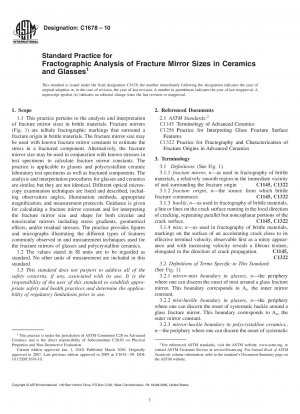ASTM C1678-10
Standard Practice for Fractographic Analysis of Fracture Mirror Sizes in Ceramics and Glasses
- Standard No.
- ASTM C1678-10
- Release Date
- 2010
- Published By
- American Society for Testing and Materials (ASTM)
- Status
- Replace By
- ASTM C1678-10(2015)
- Latest
- ASTM C1678-21
- Scope
Fracture mirror size analysis is a powerful tool for analyzing glass and ceramic fractures. Fracture mirrors are telltale fractographic markings in brittle materials that surround a fracture origin as discussed in Practices C1256 and C1322. Fig. 1 shows a schematic with key features identified. Fig. 2 shows an example in glass. The fracture mirror region is very smooth and highly reflective in glasses, hence the name “fracture mirror.” In fact, high magnification microscopy reveals that, even within the mirror region in glasses, there are very fine features and escalating roughness as the crack advances away from the origin. These are submicrometer in size and hence are not discernable with an optical microscope. Early investigators interpreted fracture mirrors as having discrete boundaries including a “mirror-mist” boundary and also a “mist-hackle” boundary in glasses. These were also termed “inner mirror” or “outer mirror” boundaries, respectively. It is now known that there are no discrete boundaries corresponding to specific changes in the fractographic features. Surface roughness increases gradually from well within the fracture mirror to beyond the apparent boundaries. The boundaries were a matter of interpretation, the resolving power of the microscope, and the mode of viewing. In very weak specimens, the mirror may be larger than the specimen or component and the boundaries will not be present.
Figs. 3-5 show examples in ceramics. In polycrystalline ceramics, the qualifier “relatively” as in “relatively smooth” must be used, since there is an inherent roughness from the microstructure even in the area immediately surrounding the origin. In coarse-grained or porous ceramics, it may be impossible to identify a mirror boundary. In polycrystalline ceramics, it is highly unlikely that a mirror-mist boundary can be detected due to the inherent roughness created by the crack-microstructure interactions, even within the mirror. The word “systematic” in the definition for “mirror-hackle boundary in polycrystalline ceramics” requires some elaboration. Mirror boundary hackle lines are velocity hackle lines created after the radiating crack reaches terminal velocity. However, premature, isolated hackle can in some instances be generated well within a ceramic fracture mirror. It should be disregarded when judging the mirror boundary. Wake hackle from an isolated obstacle inside the mirror (such as a large grain or agglomerate) can trigger early “premature” hackle lines. Steps in scratches or grinding flaws can trigger hackle lines that emanate from the origin itself. Sometimes the microstructure of polycrystalline ceramics creates severe judgment problems in ceramic matrix composites (particulate, whisker, or platelet) or self-reinforced ceramics whereby elongated and interlocking grains impart greater fracture resistance. Mirrors may be plainly evident at low magnifications, but accurate assessment of their size can be difficult. Th......
ASTM C1678-10 Referenced Document
- ASTM C1145 Standard Terminology of Advanced Ceramics
- ASTM C1256 Standard Practice for Interpreting Glass Fracture Surface Features
- ASTM C1322 Standard Practice for Fractography and Characterization of Fracture Origins in Advanced Ceramics
ASTM C1678-10 history
- 2021 ASTM C1678-21 Standard Practice for Fractographic Analysis of Fracture Mirror Sizes in Ceramics and Glasses
- 2010 ASTM C1678-10(2015) Standard Practice for Fractographic Analysis of Fracture Mirror Sizes in Ceramics and Glasses
- 2010 ASTM C1678-10 Standard Practice for Fractographic Analysis of Fracture Mirror Sizes in Ceramics and Glasses
- 2009 ASTM C1678-09 Standard Practice for Fractographic Analysis of Fracture Mirror Sizes in Ceramics and Glasses
- 2007 ASTM C1678-07 Standard Practice for Fractographic Analysis of Fracture Mirror Sizes in Ceramics and Glasses
